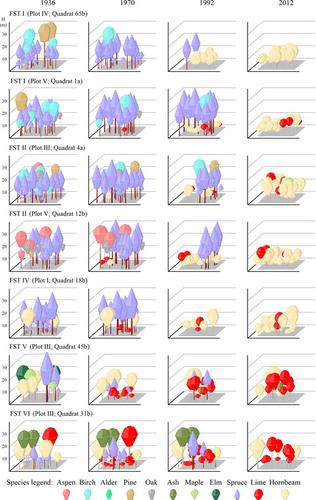Our official English website, www.x-mol.net, welcomes your
feedback! (Note: you will need to create a separate account there.)
Over 80 years without major disturbance, late‐successional Białowieża woodlands exhibit complex dynamism, with coherent compositional shifts towards true old‐growth conditions
Journal of Ecology ( IF 5.3 ) Pub Date : 2020-03-07 , DOI: 10.1111/1365-2745.13367 Bogdan Brzeziecki 1 , Kerry Woods 2 , Leszek Bolibok 1 , Jacek Zajączkowski 1 , Stanisław Drozdowski 1 , Kamil Bielak 1 , Henryk Żybura 1
中文翻译:

80多年来,在没有重大干扰的情况下,后来的比亚沃维耶(Białowieża)林地表现出了复杂的动力,其成分向着真正的旧生长条件转变了
更新日期:2020-04-22
Journal of Ecology ( IF 5.3 ) Pub Date : 2020-03-07 , DOI: 10.1111/1365-2745.13367 Bogdan Brzeziecki 1 , Kerry Woods 2 , Leszek Bolibok 1 , Jacek Zajączkowski 1 , Stanisław Drozdowski 1 , Kamil Bielak 1 , Henryk Żybura 1
Affiliation

|
- Controversies about successional dynamics of woodland communities have a long history, dating back to the classical debates between Clements and Gleason and continuing into the present. These debates have largely concerned the predictability or convergence of forest developmental trends as well as the relative importance of different mechanisms and forces driving forest succession. However, opportunities for rigorous testing of competing hypotheses are limited, mainly because plot‐based studies of forest vegetation spanning more than a decade are scarce and even fewer concern late‐successional stands.
- We exploit a unique long‐term dataset from mesic temperate forests of eastern Poland, spanning c. 80 years (1936–2012) in strictly protected, late‐successional woodlands assigned to seven different ‘structural types’. We use non‐metric multidimensional scaling to assess the stability of species composition over the study period. We examine the predictability of composition and change trajectories over time using Mantel statistics, and we examine the changes in distributions of dissimilarity indices to assess convergence or divergence at the examined time and spatial scales.
- Tree communities in Białowieża Forest have changed substantially over the last eight decades. Several species (aspen, birch, pine, oak, ash, maple and spruce) exhibited large decreases in density, while a few other species (especially hornbeam and lime) have increased in importance across a wide range of initial compositional types. Forest types recognized in earlier periods have become much less distinguishable. Metrics do not yet show clear successional convergence, mainly due to (a) decline in the previously broadly distributed spruce and (b) persistence of large individuals of intermediate, long‐lived species (even though these species lack significant regeneration).
- Synthesis. Late‐successional woodland communities of Białowieża Forest are clearly dynamic and do not show quasi‐equilibrial properties often assumed of old‐growth forests. Forest types previously recognized as distinct have become progressively less differentiated. Plausible explanations invoke alteration in competitive relationships due to complex changes in environment, including warming climate, N deposition, natural and human disturbance, and ungulate herbivory over 80 years. Hornbeam and lime have been favoured over spruce, pine, oak and birch, although potential successional convergence is far from complete at this time. In the absence of major disturbance, we expect future decades to show continued successional homogenization.
中文翻译:

80多年来,在没有重大干扰的情况下,后来的比亚沃维耶(Białowieża)林地表现出了复杂的动力,其成分向着真正的旧生长条件转变了
- 关于林地社区演替动态的争论历史悠久,可以追溯到克莱门茨和格里森之间的经典辩论,一直持续到现在。这些辩论主要涉及森林发展趋势的可预测性或趋同性,以及驱动森林演替的不同机制和力量的相对重要性。但是,对竞争性假设进行严格检验的机会是有限的,这主要是因为基于情节的对超过十年的森林植被研究很少,而对后期成功立场的关注甚至更少。
- 我们利用波兰东部中温带森林的独特长期数据集,跨度为c。80年(1936年至2012年)属于严格保护的,后继成功的林地,被分配给七个不同的“结构类型”。我们使用非度量多维标度来评估研究期内物种组成的稳定性。我们使用Mantel统计数据检查组成和变化轨迹随时间的可预测性,并检查相异性指数分布的变化,以评估所检查的时间和空间尺度上的收敛或发散。
- 在过去的八十年中,比亚沃维耶阿森林的树木群落发生了巨大变化。几种树种(白杨,桦树,松树,橡树,白蜡木,枫树和云杉)的密度显着降低,而其他几种树种(尤其是角树和石灰)在各种初始组成类型中的重要性也有所提高。较早时期公认的森林类型已经变得难以区分。度量标准尚未显示出清晰的连续收敛性,这主要是由于(a)先前广泛分布的云杉下降和(b)中间长寿物种的大个体的持久性(即使这些物种缺乏明显的再生能力)。
- 合成。Białowieża森林的后期成功林地群落显然是动态的,没有显示出通常认为是老龄森林的准平衡性质。先前被认为是独特的森林类型已经逐渐变得越来越少。由于环境的复杂变化,包括80年来气候变暖,氮沉降,自然和人为干扰以及有蹄类食草动物,合理的解释会引起竞争关系的改变。角树和酸橙比云杉,松树,橡树和桦树更受青睐,尽管此时潜在的连续收敛距离还很远。在没有重大干扰的情况下,我们预计未来几十年将显示出持续的连续均质化。











































 京公网安备 11010802027423号
京公网安备 11010802027423号